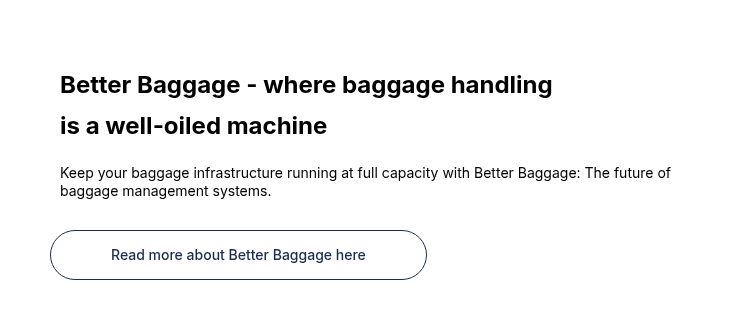Baggage infrastructure plays a vital role in airport operations. Even so, many airports find optimizing baggage infrastructure a challenging task, and that causes a variety of issues for their airport operations.
Suboptimal baggage handling flows cause everything from congested belts to overloaded early bag storage, and unnecessary, long wait times at baggage reclaim result in frustrated and dissatisfied passengers. The good news is that it doesn’t have to be this way—and that’s what we’re here to show you.
In this article, we’ll cover three essential data sources to optimize your airport baggage infrastructure and keep your baggage flows running smoothly. Let’s get into it.
What drives demand for baggage infrastructure?
Demand for baggage infrastructure is driven by multiple factors, including the number of bags per flight, the demand for segregations, the baggage infrastructure layout, and the handling agent setup at the airport.
To optimize the baggage infrastructure of your airport, it’s essential to achieve a complete understanding of two main things:
- When are bags arriving?
- How many bags are arriving?
Bag arrivals are impacted by a variety of factors. For example, we often see that leisure passengers and passengers traveling long-haul will be traveling with more bags, whereas business passengers will often travel light or with no bags at all.
Below, we’ll take a look at three data sources that will help you achieve a thorough understanding of baggage arrivals and optimize the baggage infrastructure of your airport.
3 essential data sources for optimizing your baggage infrastructure
1. The baggage tag
When it comes to understanding baggage arrivals, one of the most important sources of data available to us is the baggage tag.
The baggage tag holds valuable information on baggage scan times. This includes:
- Baggage Source Message (BSM): The Baggage Source Message contains real-time information on the bag itinerary (time and date, flight(s), destination(s)), and whether the bag is local or connecting.
- Baggage Processed Message (BPM): The Baggage Processed Message is an update tagged onto the BSM. It’s local to the airport and is updated with real-time information on the bag as it travels through the baggage system, including potential time stamps for check-in, screening, sortation, early baggage storage, and more.
The BSM data covers the full journey of the bag as it travels from origin to the final destination, allowing your airport to analyze onwards segments yourself. This enables you to challenge airlines and handling agents on their need for segregations.
2. Baggage arrival curves
When we aggregate the information of the BSM and BPM, the result allows us to see what the baggage arrival curves look like — the next valuable source of data on the agenda.
Baggage arrival curves show how bags arrive for the flight. They’re important because they should drive the demand for baggage make-up positions (MUPs) and inbound reclaim belt allocations.
Airports often allocate resources evenly throughout a given time frame. But what if you could allocate resources dynamically based on demand instead?
Allocating by demand helps ensure that your resources are utilized optimally and are not wasted during times when they are less needed. An airport’s ability to allocate by demand, however, often comes down to the infrastructure of the airport.
For example, if you have laterals, allocating by demand can be challenging, as it can be difficult to allocate multiple airlines to the same lateral. If you have chutes, it is easier to allocate fewer MUPs per flight — but the need for multiple segregations can be a challenge. If you have race tracks, you have almost full flexibility in terms of MUP allocation — but racetracks require manual sortation, which can lead to sortation errors.
3. Outbound and inbound infrastructure
As mentioned, your airport’s infrastructure plays an important role in your ability to allocate resources by demand — particularly your baggage infrastructure.
When optimizing your baggage infrastructure, it’s crucial to take both your outbound and inbound infrastructure into consideration.
Key elements to consider for outbound infrastructure include:
- Chutes: With chutes, it’s easy to make segregations. However, it’s difficult to store bags in chute MUPs, and full unit load devices (ULDs) will need to be placed elsewhere.
- Laterals: Laterals provide the option of a little more storage. However, laterals can only accommodate 1-2 flights from the same airline with the same handling agent.
- Race tracks: Race tracks offer flexibility and can accommodate many flights. However, they also place the responsibility of sorting bags correctly onto the handling agent.
As for inbound infrastructure, key elements to consider include:
- Race tracks: The length of the race track belt is key. If the belt is 60 meters long, but 20 meters are against a wall, only 40 meters are available for passengers to use. It’s important to consider how many meters passengers are actually able to line up against.
- 'Offload infrastructure: An element which is sometimes overlooked is that the race track belt needs to be fed from the secure airside area, making it key to understand the offload infrastructure surrounding the race track. The length of one offload belt may differ from another, meaning you may have a longer belt for a shorter carousel. If an offload belt can only fit three sorting positions, it may not be a good match for the longer race track belt.
Considerations when optimizing baggage infrastructure
The three data sources above provide us with key information to consider when it comes to optimizing airport baggage infrastructure.
Key input to consider includes:
- How many bags should be sorted per MUP per hour?
- Which flights can be sorted in the infrastructure?
- What preferences do airlines have? Which are nice-to-have preferences, and which are need-to-have preferences?
- How can you achieve dynamic openings of MUPs by leveraging early bag storage (EBS)?
By leveraging the three data sources discussed above, you will be able to answer these questions and use the information to optimize your baggage infrastructure.
Want to delve deeper into the challenges of optimizing airport baggage infrastructure? Click here to watch the webinar our Co-CEO and founder, Kasper Hounsgaard, recently hosted on the subject.
Optimize your baggage infrastructure with Copenhagen Optimization
Imagine an airport where baggage flows are balanced and baggage handling systems always run smoothly. A baggage management system that enables smooth, dynamic, and flexible baggage planning, baggage reclaim, and reduced reclaim wait times.
At Copenhagen Optimization, we want to help you achieve just that. That’s why we have developed Better Baggage: the baggage management system to keep your baggage infrastructure running at full capacity.
With accurate daily forecasting of incoming bag numbers, Better Baggage enables your airport to optimize its MUPs, EBS set-up, and baggage handling system flows. Switching from seasonal planning to dynamic daily planning means you’re always using your MUP resources optimally while your EBS is never overloaded. A live integration also allows for data-driven decision making on the spot.
A cloud-based SaaS solution, Better Baggage requires no on-site installation and is accessible through your preferred web browser. All users are looking at and working with the same updated plans. The baggage management system produces plans automatically upon calibration and eliminates manual processes. This enables baggage MUP allocation to be done in 30 minutes for a full week, allowing you to optimize your outbound infrastructure, maximize the potential of your baggage handling system, and bring your baggage management into the future.

Optimize your airport operation with Copenhagen Optimization
Efficient passenger and baggage flows are crucial to minimizing wait times, reducing congestion, and ensuring smooth airport operations all around. This makes managing passenger and baggage flows a central aspect of ensuring operational efficiency in the modern airport.
For the modern airport to reach its full potential of operational efficiency, its operations must be connected. This is why Copenhagen Optimization has developed Better Airport®: a cloud-based airport management SaaS platform that gives all airports, regardless of size, a simpler way to run core operations.
Better Airport utilizes all the data points that your airport has access to, enabling your airport to get the most value out of the available data. This allows you to better manage your operations — from forecasting and planning to day-of-operation and real-time adjustments — and enhance the value of your AODB.





